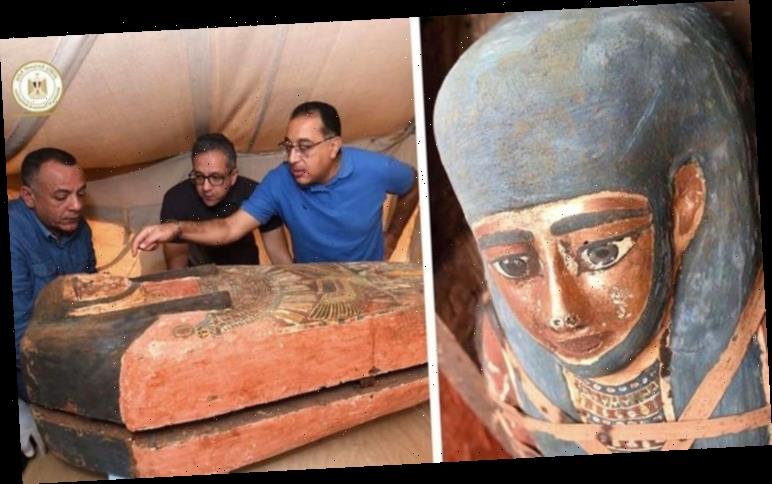The discovery expands an already impressive collection of coffins discovered at the ancient necropolis of Saqqara in northern Egypt. Khaled El-Enany, Egypt’s Tourism and Antiquities Minister, confirmed on Monday “a huge number” of new coffins has been found, adding to the 59 already found at the site. Archaeologists studying the necropolis believe the sarcophagi could be more than 2,500 years old.
And although an official statement is yet to be made, Mr El-Enany took to Instagram yesterday to tease the most recent findings.
Among them, he highlighted the discovery of three new burial wells as “dozens of colourful” sarcophagi.
The archaeologists also unearthed a number of painted and gilded statues.
Mr El-Enany, who was joined by Egypt’s prime minister Mustafa Madbouly, said: “Honored to have our PM HE Dr Mostafa Madbouly visit today our new discovery in Saqqara.
“More burial shafts that contain dozens of coloured coffins sealed since ancient times are discovered.
“We will announce the details of this discovery soon…”
The archaeologists are expected to reveal more in the coming weeks, leading to an official press event.
The Saqqara necropolis sits about 19 miles south of Cairo in the ancient Egyptian capital of Memphis.
The site is home to Egypt’s oldest surviving pyramid, the 4,700-year-old Djoser pyramid.
But many more pyramids are found at the site in various states of decay.
The Pyramid of Djoser itself was closed to the public for 14 years during which it underwent an extensive restoration effort.
The site suffered damage during the 2011 Egyptian protests when looters raided Saqqara and the surrounding areas.
Saqqara remained in use for burial for more than 3,000 years, well into the Roman times.
DON’T MISS…
Archaeology treasure found at King David’s ‘lost Biblical city’ [REPORT]
Egypt’s Great Pyramid tipped for major discovery [INSIGHT]
Egypt archaeology: Ancient wall reliefs expose Israel’s greatest enemy [INTERVIEW]
In September this year, archaeologists at Saqqara unearthed nearly 30 coffins hidden away in a burial shaft about 39ft deep.
And a month later, Egypt’s Ministry of Tourism and Antiquities announced the discovery of another 59 coffins with preserved remains inside.
According to Mostafa Waziri, secretary-general of the Supreme Council of Antiquities, an initial analysis found the sarcophagi dated to the Pharaonic Late Period between 663 and 525 BC.
The intricately decorated coffins were likely made for priests and high ranking officials and elites.
At the time, Mr El-Enany said: “I consider this is the beginning of a big discovery.”
Alongside the coffins, archaeologists found 28 statues of Ptah-Soker, the chief deity of the necropolis.
A bronze statue of the god Nefertem was also found with the name of its owner, the priest Badi-Amun, inscribed on its base.
The wide range of discoveries at Saqqara has been dated between the First Dynasty (2920 to 2770 BC) and the Coptic Period (395 to 642 AD).
Source: Read Full Article




